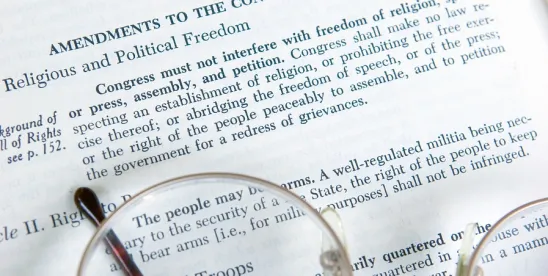The U.S. Court of Appeals for the First Circuit recently found in favor of the Town of Pembroke, New Hampshire regarding the Town’s denial of an application for an electronic sign permit for religious messages. The Town’s Zoning Board of Adjustment (Board) denied the permit because it believed the sign would “detract from the rural character of the Route 3 corridor” and noted the Town’s interest in maintaining its “quaint little New England village” aesthetic. Signs for Jesus and Hillside Baptist Church (collectively, the Church) sued the Town after the Board denied a permit to install an electronic sign on Hillside Baptist Church’s property which would transmit messages provided by Signs for Jesus. According to the Church, the denial of the permit and the Town’s local sign code violated the First Amendment to the U.S. Constitution, RLUIPA’s equal terms and substantial burden provisions, and state law. The First Circuit did not agree. It affirmed the District Court’s decision granting summary judgment to the Town. Our post regarding that decision is available here.
The Church’s RLUIPA equal terms claim failed because the Church could not identify a similarly situated secular comparator. It contended that a public school, Pembroke Academy, and the New Hampshire Department of Transportation (NHDOT) were comparators because they both had electronic signs in the same zoning district as the Church. The First Circuit concluded otherwise. The public school and NHDOT were governmental land uses regulated by the state. The Town had no power to regulate land uses owned or occupied by the state or school district, so the public school and NHDOT were not valid comparators. The Court found the Church’s equal protection claim failed for similar reasons.
The Church’s substantial burden claim under RLUIPA fared no better. The First Circuit reiterated the three factors it considers when analyzing substantial burden claims: (a) whether the regulation at issue appears to target religion based on hostility against religion; (b) whether the regulation was imposed on the religious institution arbitrarily, capriciously or unlawfully; and (c) whether local regulators have subjected the religious organization to a process that may appear neutral on its face but in practice is designed to reach a predetermined outcome contrary to the group’s requests.
The Church relied on the third factor and argued that the Board prejudged the application before actually denying it at the hearing. It argued that its application was prejudged because some members of the Board colluded to deny the application after they met with an attorney in advance of the hearing to discuss the Church’s application. At this meeting, the attorney provided the Board members with a draft motion to deny the application but did not provide an equivalent draft of a motion for approval. However, a member of the Board testified that the purpose of drafting the motion to deny was to ensure that the Board “knew the motion that we had to make if we were going to deny,” and that he “didn’t know whether we were going to approve or deny [the request] until the end of the meeting.” There was also evidence that the Board consulted with the lawyer because the Church hired “expensive counsel” who had raised issues of federal law. The First Circuit sided with the Town: “[T]he fact that the Board had counsel ready is not a basis on which a jury could conclude that the Board improperly prejudged the decision.” The reason that there was only a draft motion for denial was because a motion for approval would have been simple to draft. By contrast, a draft motion for denial required the Board to state the reasons for the denial.
The First Circuit also found that provisions of the Town’s sign ordinance did not violate free speech protections. It was not persuaded by the Church’s contention that certain elements of the sign ordinance were content-based, including an exemption for government signage. The Church also argued that restricting electronic signs to just one zoning district reflected a preference for commercial speech and was therefore content-based. The Court disagreed. It concluded that there was nothing to support the Church’s argument that locational rules imposed on churches were a pretext for the Town to regulate the content of speech with respect to the use of electronic signs. The Town’s sign code provisions satisfied intermediate scruinty. The Court emphasized the Town’s interest in maintaining its “quaint little New England village” aesthetic. Finally, the court was not convinced that the sign ordinance vested unbridled discretion in the Town to determine which signs are and are not permitted without narrow, objective and definite criteria.
The decision in Signs for Jesus v. Town of Pembroke (1st Cir. 2020) is available here.



 />i
/>i
